Pedro G. Vaz
Re-ordering of Hadamard matrix using Fourier transform and gray-level co-occurrence matrix for compressive single-pixel imaging
Mar 09, 2022



Abstract:One of the most active research fields in single-pixel imaging is the influence of the sampling basis and its order in the quality of the reconstructed images. This paper presents two new orders, ascending scale (AS) and ascending inertia (AI), of the Hadamard basis and test their performance, using simulation and experimental methods, for low sampling ratios (0.5 to 0.01). These orders were compared with two state-of-the-art orders, cake-cutting (CC) and total gradient (TG), using TVAL3 as the reconstruction algorithm and three noise levels. These newly proposed orders have better reconstructed image quality on the simulation data set (110 images) and achieved structure similarity index values higher than CC order. The experimental data set (2 images) showed that the AS and AI orders performed better with a sampling ratio of 0.5, while for lower sampling ratio the performance of AS, AI and CC was similar. The TG order performed worst in the majority of the cases. Finally, the simulation results present clear evidence that peak signal-to-noise ratio (PSNR) is not a reliable image quality assessment (IQA) metric to assess image reconstruction quality in the context of single pixel imaging.
Automatic Segmentation of the Optic Nerve Head Region in Optical Coherence Tomography: A Methodological Review
Sep 06, 2021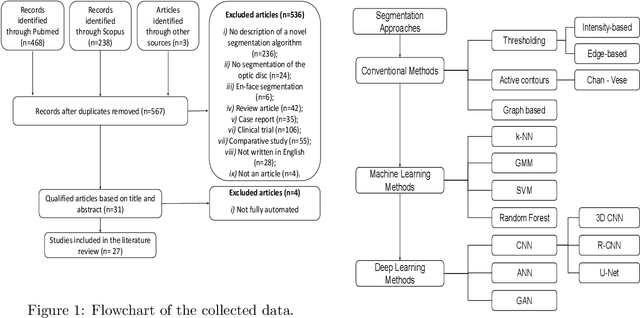
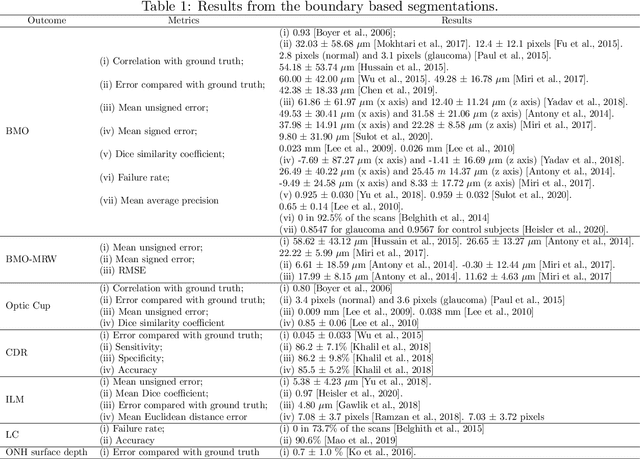
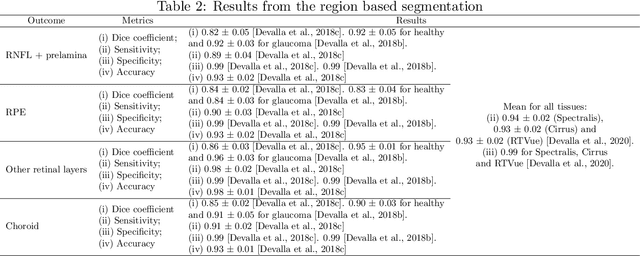
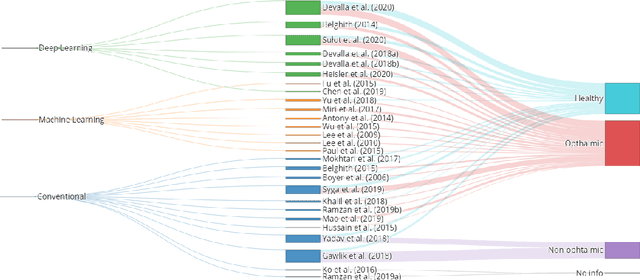
Abstract:The optic nerve head represents the intraocular section of the optic nerve (ONH), which is prone to damage by intraocular pressure. The advent of optical coherence tomography (OCT) has enabled the evaluation of novel optic nerve head parameters, namely the depth and curvature of the lamina cribrosa (LC). Together with the Bruch's membrane opening minimum-rim-width, these seem to be promising optic nerve head parameters for diagnosis and monitoring of retinal diseases such as glaucoma. Nonetheless, these optical coherence tomography derived biomarkers are mostly extracted through manual segmentation, which is time-consuming and prone to bias, thus limiting their usability in clinical practice. The automatic segmentation of optic nerve head in OCT scans could further improve the current clinical management of glaucoma and other diseases. This review summarizes the current state-of-the-art in automatic segmentation of the ONH in OCT. PubMed and Scopus were used to perform a systematic review. Additional works from other databases (IEEE, Google Scholar and ARVO IOVS) were also included, resulting in a total of 27 reviewed studies. For each algorithm, the methods, the size and type of dataset used for validation, and the respective results were carefully analyzed. The results show that deep learning-based algorithms provide the highest accuracy, sensitivity and specificity for segmenting the different structures of the ONH including the LC. However, a lack of consensus regarding the definition of segmented regions, extracted parameters and validation approaches has been observed, highlighting the importance and need of standardized methodologies for ONH segmentation.
Signal-carrying speckle in Optical Coherence Tomography: a methodological review on biomedical applications
Aug 30, 2021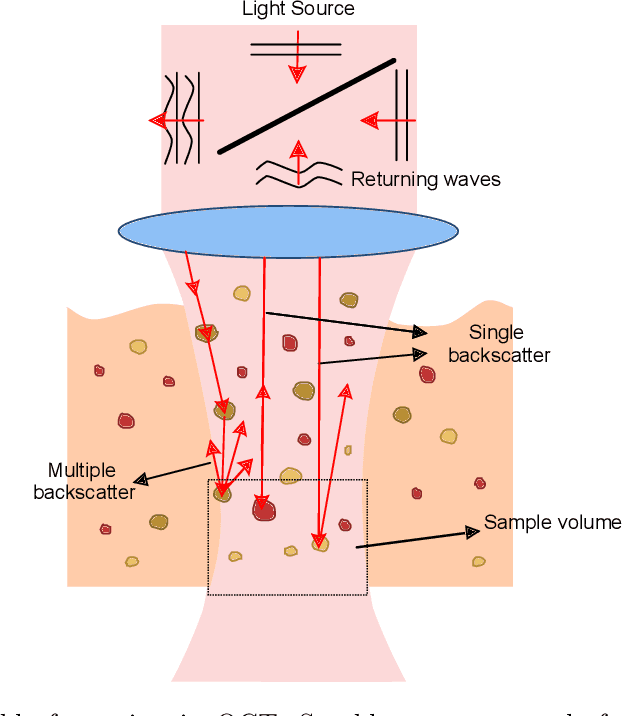
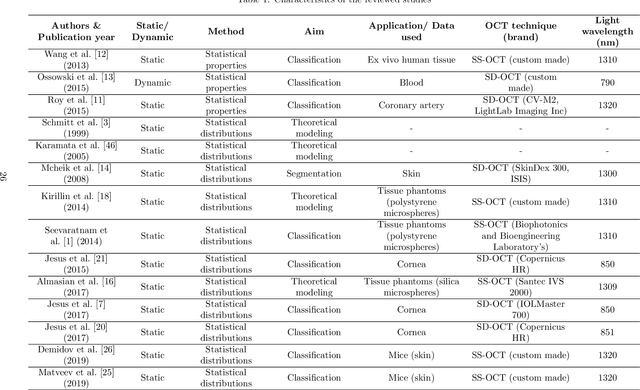
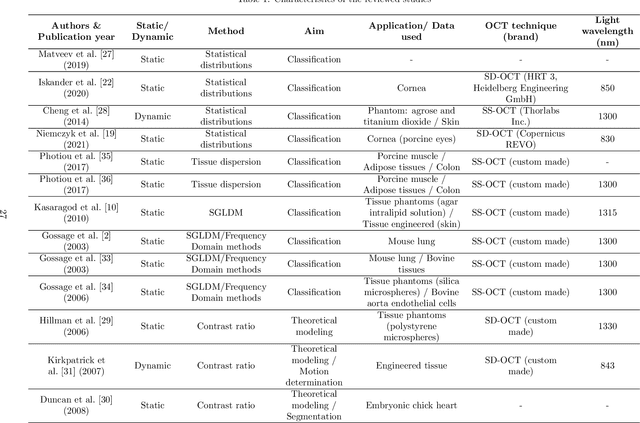
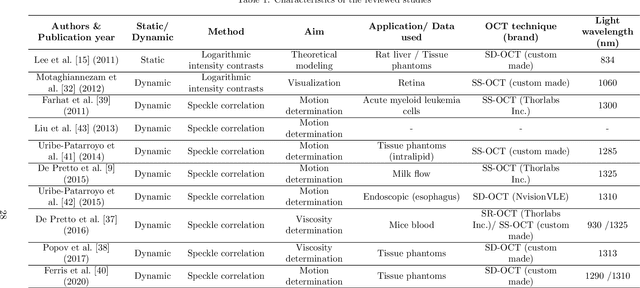
Abstract:Significance: Speckle has historically been considered a source of noise in coherent light imaging. However, a number of works in optical coherence tomography (OCT) imaging have shown that speckle patterns may contain relevant information regarding sub-resolution and structural properties of the tissues from which it is originated. Aim: The objective of this work is to provide a comprehensive overview of the methods developed for retrieving speckle information in biomedical OCT applications. Approach: PubMed and Scopus databases were used to perform a systematic review on studies published until April 2021. From 134-screened studies, 37 were eligible for this review. Results: The studies have been clustered according to the nature of their analysis, namely static or dynamic, and all features were described and analysed. The results show that features retrieved from speckle can be used successfully in different applications, such as classification and segmentation. However, the results also show that speckle analysis is highly application-dependant, and the best approach varies between applications. Conclusions: Several of the reviewed analysis were only performed in a theoretical context or using phantoms, showing that signal-carrying speckle analysis in OCT imaging is still in its early stage, and further work is needed to validate its applicability and reproducibility in a clinical context.
 Add to Chrome
Add to Chrome Add to Firefox
Add to Firefox Add to Edge
Add to Edge